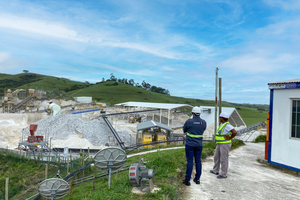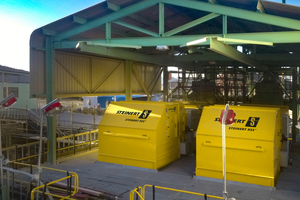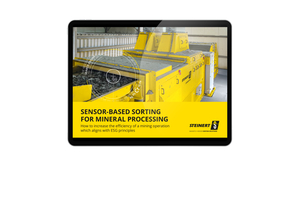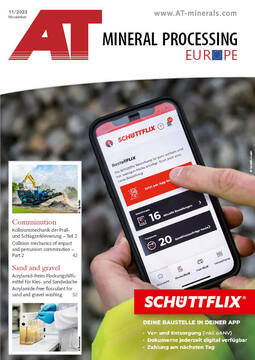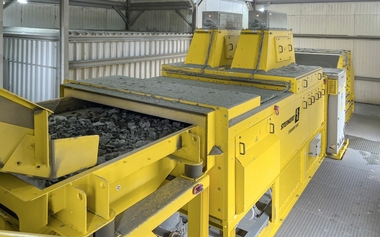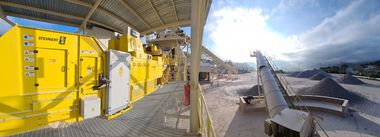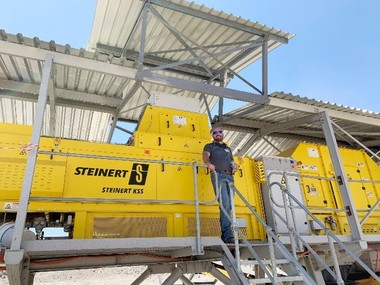How sensor-based sorting technology makes mining profitable in line with ESG principles
By combining up to four sensors, STEINERT’s sorting systems maximises precision. These technologies greatly reduce operating costs, increase the value of the output material and are environmentally friendly. This makes mining companies able to comply with ever more stringent ESG criteria (environmental, social, governance) while also operating at a profit, which in turn has a positive impact on local communities.
With the ever-increasing demand for raw materials and a growing awareness of environmental responsibility, the mining industry is realigning its priorities. Protecting the natural environment and using natural resources sustainably is not only a social requirement but are often also prescribed by law.
The general shortage of resources is leading to increasing prices for energy, consumption of the natural environment and of certain raw materials obtained through mining. This shift is boosting the inherent advantages of sensor-based sorting beyond the processes commonly used to date. Thanks to low operating costs and good selectivity, pre-concentrating raw material, for example, enables efficiency gains. This can make the mining of low-grade ores profitable or secondary mining, such as the processing of mine dumps, lucrative.
The benefits of combined sensors
Sorting technology delivers a multitude of benefits in mining. Unlike wet processing, water does not have to be stored or treated. This also eliminates the need of tailings. In many cases, pre-concentration can be set up under ground. This cuts the costs of transport because some of the excavated material does not have to be brought to the surface. Compared with wet separation, dry sorting is generally cheaper and less harmful to the environment. Sorting specialist STEINERT has produced a multi-sensor response to the increasingly complex requirements of sorting depth, energy efficiency and environmental compatibility. The software for the sorting algorithm can also be continually adapted to new requirements as they emerge. Mining companies stand to gain from the following benefits of sensor-based sorting:
reduction in the volumes that need to be moved and
processed as the raw material is pre-sorted
scope for processing low-grade ores (as this shifts to a point at which it is profitable)
processing of stockpiles or other “secondary mining deposits”
if the ore displays certain characteristics, a concentrate of valuable material can be produced directly
Stockpiles: an application with potential
Secondary mining, such as the removal and processing of stockpiles, is becoming increasingly important. These stockpiles are an unavoidable element of mining and are usually operated either until they get too large or statutory requirements mean that they have to be removed. However, standard processes may prove cost prohibitive due to the low level of valuable materials in these heaps making such work unprofitable. As a result, the removal of stockpiles entails significant costs for tearing them down and transporting them without any gain.
Effective sorting technology solves this challenge. The lower the share of low-grade rock, the easier it is to make the process profitable. The level of valuable materials in pre-concentrates produced using sensor sorting often corresponds to that of primary ores. STEINERT provides specialised sorting systems for various applications. The options available to suit specific requirements include XRT (x-ray transmission), or NIR (near-infrared) with optional laser, inductive detection and optics.
A combination of sensors enables accurate sorting
STEINERT’s sensor-based sorting facilities combine the data from up to four sensors for a level of sorting precision never seen before. The sorting system for dry density separation STEINERT KSS | XT CLI analyses the material to be sorted with X-ray transmission. The sorting system can be equipped with additional sensors depending on requirements. Optical sensors record surface characteristics and colour information, and an inductive sensor detects metals and various conductive minerals.
This system is ideally suited to processing gold, non-ferrous metal and iron ores, or various industrial minerals such as phosphate. The high value extraction of STEINERT sorting systems is one key reason why Hildebrand Wilhelm installed them in its QKR gold mine in Namibia: “The interesting thing about the sorting technology is that it runs at only 1/5 of our conventional operating costs. The technology was easy to work with. STEINERT training packages and field support were key to preparing our operations and maintenance team for a smooth transition from installation to operations. In general, we double the grade of our input material and that is where the value is generated.”
Another alternative is the STEINERT KSS | NR CLI with near-infrared detection as the main sensor. This is particularly well suited to sorting industrial minerals such as dolomite, spodumene (source of lithium), fluorite, limestone, quartz and much more.
ESG-compliant processes
There is less and less tolerance for environmental wastage and greenhouse gas emissions. Even in less developed regions of the world, people and authorities are increasingly placing greater importance on compliance with ESG criteria. ESG stands for environmental, social and corporate governance. These criteria set the agenda for consideration of environmental, sustainable and social issues within business management, public bodies, governments and authorities. Since sensor-based sorting increases the efficiency and profitability of your operations, it becomes easier for you to comply with these criteria while also running a profitable business. Local communities in the vicinity of the mines stand to benefit in turn through the health, social and economic benefits delivered.

